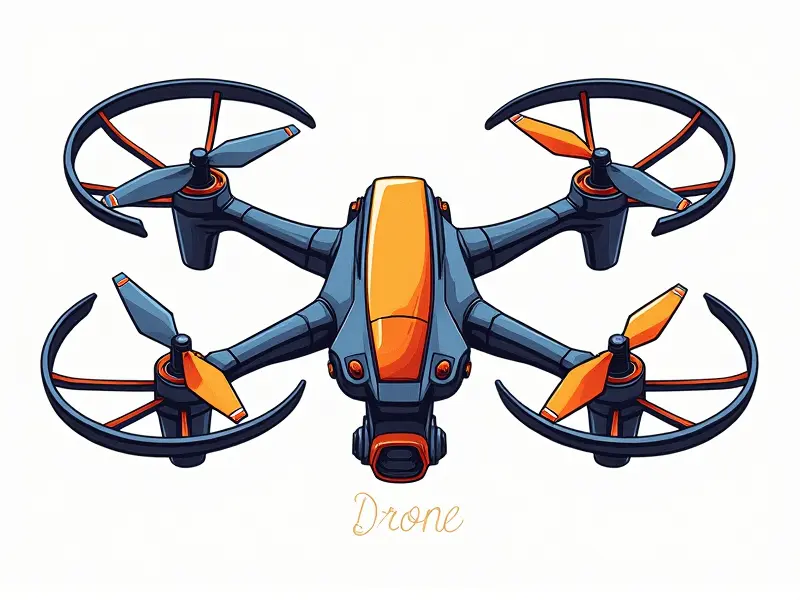FPV drone frame material?

FPV Drone Frame Material: Choosing the Best for Your Needs
When it comes to FPV (First Person View) drone racing, selecting the right frame material is crucial. The choice of material can significantly impact performance, durability, and overall cost. This article delves into the top materials used in FPV drone frames, providing insights on their advantages and disadvantages.
Why Carbon Fiber is King in FPV Frames
Carbon fiber has become synonymous with high-performance FPV drones due to its exceptional properties:
- Lightweight: Carbon fiber offers an unmatched weight-to-strength ratio, making it ideal for achieving top speeds and agile maneuvers.
- Durable: Despite being lightweight, carbon fiber is incredibly strong and resistant to impact. It can withstand the rigors of competitive racing without compromising structural integrity.
- Heat Resistant: Carbon fiber maintains its strength at high temperatures, which is crucial for FPV drones that generate significant heat during prolonged flight times.
Top 5 FPV Drone Frame Materials Compared
Here’s a comparison of the top five materials used in FPV drone frames:
- Carbon Fiber: The gold standard for performance and durability. It's expensive but offers unmatched benefits.
- Aramid Fibers (Kevlar): Known for their high tensile strength, aramid fibers provide excellent impact resistance at a lower cost than carbon fiber.
- Glass Fiber: A budget-friendly option that offers good rigidity and durability. It’s less expensive but heavier than carbon fiber.
- Aluminum: Durable and easy to work with, aluminum frames are popular for their balance of strength and cost-effectiveness.
- Titanium: The most durable material available, titanium is extremely lightweight yet incredibly strong. It’s also the most expensive option.
Lightweight vs Durable: FPV Frame Material Debate
The debate between lightweight and durable materials in FPV drone frames revolves around performance versus longevity:
- Lightweight Materials: Optimal for achieving high speeds, quick turns, and overall agility. However, they may be more prone to damage.
- Durable Materials: Offer better resistance to impacts and wear over time but can add weight, affecting performance.
Budget-Friendly FPV Drone Frame Options
If cost is a primary concern, consider the following budget-friendly materials:
- Glass Fiber: Provides good rigidity and durability at an affordable price point.
- Polymer Composites: Lightweight and easy to manufacture, making them cheaper than carbon fiber or titanium.
Pros and Cons of Aluminum for FPV Frames
Aluminum is a popular choice due to its balance between cost and performance:
- Pros:
- Affordable compared to carbon fiber or titanium.
- Easily machined, allowing for precise customizations.
- Durable and resistant to corrosion.
- Cons:
- Heavier than carbon fiber, affecting flight performance.
- Limited flexibility in design due to its rigidity.
Guide to Selecting the Perfect FPV Drone Frame
To choose the right material for your FPV drone frame:
- Determine Your Budget: Consider how much you’re willing to spend on materials.
- Evaluate Performance Needs: Assess whether lightweight or durability is more important for your racing style.
- Consider Durability Requirements: Think about the level of abuse your drone will endure and choose accordingly.
Impact of Material on FPV Drone Performance
The material used in an FPV frame directly influences several aspects of performance, including:
- Aerodynamics: Lightweight materials improve aerodynamic efficiency, leading to better speed and maneuverability.
- Heat Management: Materials that can handle high temperatures without degrading ensure consistent performance during long flights.
Advanced FPV Drone Frame Material Trends
The latest trends in FPV drone frame materials include:
- Nanocomposites: Combining nanotechnology with traditional composites to create ultra-lightweight yet incredibly strong frames.
- Bio-Based Materials: Sustainable options like bamboo and other plant-based fibers are gaining traction for their eco-friendliness.
Longevity and Durability in FPV Frame Materials
To ensure your FPV drone frame lasts longer, consider materials that offer high durability:
- Titanium: The most durable option available but also the most expensive.
- Aramid Fibers (Kevlar): Provide excellent impact resistance at a lower cost than titanium or carbon fiber.
Top Materials for Competitive FPV Racing Drones
The best materials for competitive racing drones include:
- Carbon Fiber: The go-to material for high-performance racing due to its lightweight and durability.
- Nanocomposites: Cutting-edge technology offering unparalleled strength-to-weight ratios.
Innovative Materials Shaping FPV Drone Frames
New materials are revolutionizing the world of FPV drone frames, including:
- Bio-Based Composites: Sustainable and eco-friendly options that offer comparable performance to traditional materials.
- Nanomaterials: Incorporating nanotechnology for enhanced strength and flexibility in frame design.
Conclusion
Selecting the right material for your FPV drone frame is a critical decision that can significantly impact performance, durability, and cost. Whether you opt for carbon fiber, aluminum, or one of the emerging innovative materials, understanding the pros and cons will help you make an informed choice tailored to your specific needs.

